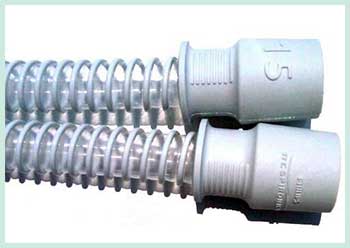Continuous Positive Airway Pressure (CPAP) therapy is a common and effective treatment for sleep apnea. A key component of the CPAP system is the tubing that connects the CPAP machine to your face mask.
This tubing comes in different sizes, with the most common being 15mm and 22mm diameter tubing. But does tubing size really matter when it comes to effective CPAP therapy?
Comparison Table
| Feature | 15mm Tubing | 22mm Tubing |
| Flexibility | Excellent – lightweight and maneuverable | Stiffer, more prone to tangling |
| Airflow Resistance | Minimal for most – slightly increased at very high pressures | Better airflow, less obstruction |
| Ease of Use | Easier portability and storage | Universal connections fit all machines |
| Mask Compatibility | May require special adaptors /fittings | Fits nearly all masks directly |
| Appearance | Slim and low profile | Bulky, more clinical aesthetic |
| Price | Roughly the same | Roughly the same |
How Does CPAP Tubing Work?
CPAP tubing carries pressurized air from the CPAP machine to your mask. This constant flow of air helps keep your airway open while you sleep, preventing airway collapse that causes sleep apnea. The tubing needs to be large enough in diameter to allow sufficient air flow, but small enough to avoid excess bulk and discomfort.
Most CPAP machines have standard 22mm tubing connections. So historically, 22mm became the conventional tubing size. However, many patients complained of bulky, inflexible tubing that would tangle and pull on their mask at night. This led to the introduction of slimmer, more flexible 15mm tubing.
Watch this video!
Comparing 15mm Vs. 22mm CPAP Tubing
Below we’ll explore the pros and cons of both tubing sizes to help you decide which is best for your needs:
Flexibility
The main benefit of 15mm over 22mm tubing is improved flexibility and freedom of movement. The narrower diameter makes 15mm tubing lighter and more maneuverable. Patients often report feeling less smothered and tangled up at night.

However, for some the extremely flexible nature of 15mm tubing actually increases contact and pulling on the mask. Finding a happy medium of flexibility is key for mask comfort.
Airflow Resistance
Excessively narrow tubing can increase airflow resistance. This makes the CPAP machine work harder to push enough air through the smaller pathway. Most data shows 15mm tubing has minimal impact on resistance and CPAP effectiveness for a majority of patients. But for those with very high pressure settings, the slightly wider 22mm may provide less obstructed airflow.
Ease Of Use
The smaller and lighter 15mm tubing is easier to handle, pack for travel, and route out of the way. The 22mm diameter can feel more cumbersome for portability and storage.

However, 22mm tubing fittings are universal across all CPAP machines. The smaller profile of 15mm means it may require special adaptors to fit older or other brand CPAPs.
Mask Compatibility
Most modern masks come equipped for both standard 22mm and 15mm connections. But if using an older mask model, switching to 15mm tubing may require purchasing adapter pieces for mask compatibility.
Appearance
For those concerned about aesthetics and bedroom setup, 15mm tubing simply looks less bulky and clinical over 22mm. Your bed partner may appreciate the more streamlined, low-profile appearance.
Price
There is little price difference between large and small diameter tubing options. Both tend to cost roughly the same for replacement parts.
Frequently Asked Questions (FAQ)
Tubing diameter has the biggest impact on flexibility, ease of movement, transport, and bulkiness. Airflow dynamics and resistance only start to be impacted at extreme settings. So for most CPAP users, smaller 15mm tubing primarily offers increased comfort and portability compared to traditional 22mm size.
The main difference lies in tubing flexibility, weight, transportability and overall profile. 15mm tubing has a smaller diameter, so it is lighter, more flexible, easier to manipulate, and less visually bulky. But it can require extra adaptors and may increase resistance for those running very high pressurized air settings on their CPAP machine.
Look closely at the tubing connections on your mask and machine. Standard is 22mm exterior diameter. If your tubing has smaller 15mm fittings, it may say “slimline” or “15mm” directly printed along the length of tubing.
The majority of ResMed CPAP machines and masks are equipped for their proprietary 22mm “ClimateLineAir” heated tubing system. Most ResMed products include 22mm connections as standard size.
Also Read: Littmann Cardiology IV Vs. Master: Choosing Best Stethoscope
Conclusion
When selecting 15mm Vs. 22mm diameter CPAP tubing, small and flexible wins out for most users. The freedom of movement and reduced bulkiness lead to higher patient comfort and compliance with therapy.
However, personal preference varies, so try out both options if possible to determine the best tubing solution for your needs and sleep setup. With minimal impact on performance, slim and nimble 15mm tubing brings CPAP the future focused on patient comfort.